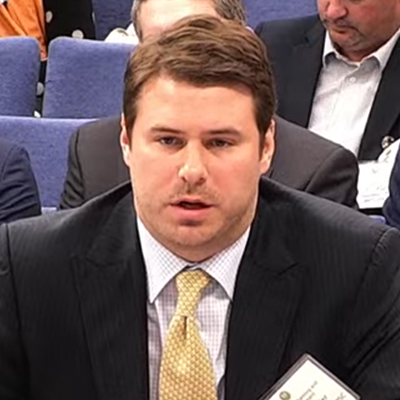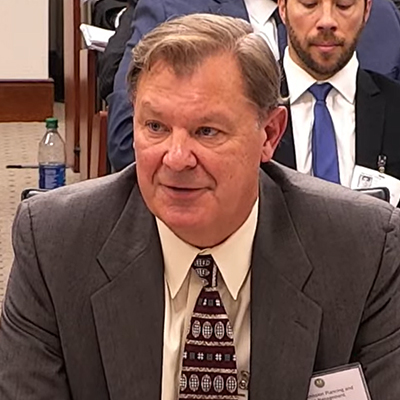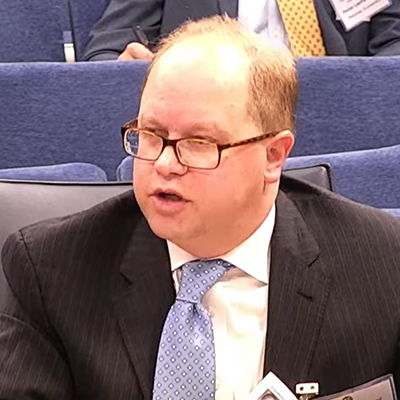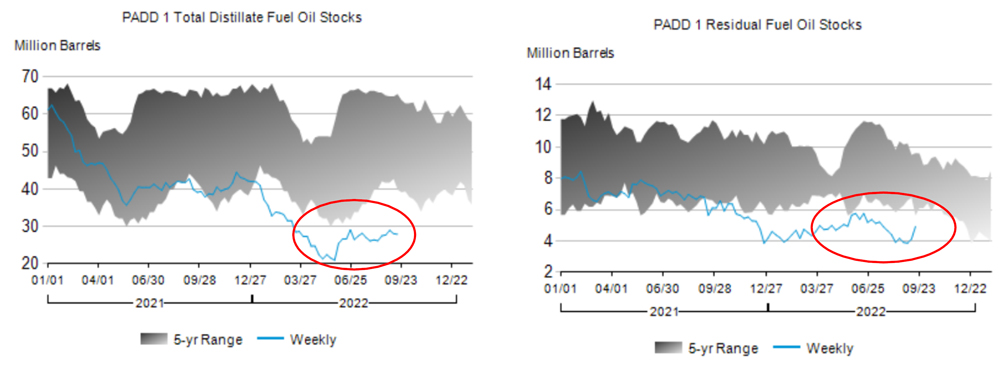FERC Commissioner Mark Christie said Thursday that the commission should consider limiting formula rate authority to transmission owners whose projects are subject to “robust” state regulatory reviews to help close the “regulatory gaps” between state, federal and RTO oversight.
Meanwhile, state officials and consumer advocates told FERC’s technical conference on transmission planning and cost controls (AD22-8) that the commission should also provide more scrutiny of formula rates, under which expenses are presumed to be just and reasonable.
Christie was incredulous when Indiana regulator Sarah Freeman, president of the Organization of MISO States, said that her state has no process for reviewing transmission projects.
“There is a gap in what scrutiny is taking place at the state level, and yet that is where all these projects should be scrutinized,” Christie, a former Virginia regulator, said at the close of the hearing. He said the testimony showed state oversight on the cost and prudence of projects “varies greatly.”
FERC has “authority over [just and reasonable] rates at the wholesale level and transmission. We don’t have authority to tell a state how to structure your CPCN [certificate of public convenience and necessity] process, but we do have authority to say who gets formula rate treatment when you come here,” Christie said. He invited stakeholders to submit comments on whether FERC should limit such rate treatment to TOs from states with a “robust state permitting process.”
“At a minimum, a robust state permitting process would be looking at, not just [the] prudence of cost, but also looking at need,” Christie said. “If you look at the three sections we’ve talked about today — the RTO planning part; the state CPCN part; and then the formula rate part [at FERC] when it comes to how to pay the bill — each one of those really connect.”
FERC Chair Richard Glick said he was taken aback by Iowa Consumer Advocate Jennifer Easler’s written testimony, which described the state’s lack of authority over the cost of local transmission projects.
“When they come in for the franchise application, we do conduct discovery on it, and we ask, ‘What alternatives did you consider?’” Easler said. “And we will get responses along the lines of, ‘We object. The costs of these projects are not regulated by the Iowa Utilities Board.’”
Glick said the conference exposed both a regulatory gap and “an informational gap,” as evidenced by regulators and consumer advocates who said they lack the access to information on local transmission plans or the expertise to evaluate them. “Those are two items I think we need to address going forward,” he said in his remarks concluding the conference. “We have, in my opinion, more work to do on transmission and hopefully more [Notices of Proposed Rulemakings] to come at some point.”
States Seek Help
FERC heard from officials of eight states and D.C. during the daylong conference.
Cameron Dyer, senior assistant general counsel for the Public Utilities Commission of Nevada, said there is only one vertically integrated investor-owned utility in his state — NV Energy — that “handles just about all the transmission in the state, which means that any time new transmission is being proposed — in the intrastate context, at least — there is a lot of robust interview, review and analysis of that new transmission.”
Most state officials were less sanguine.
The topic of the first of the five panels at the conference was the development and use of criteria for local transmission planning, where state regulators and municipal utilities told the commissioners they often don’t have any idea what those criteria are.
Under FERC Order 890, “we get the baseline reliability criteria from the transmission providers and [their] specific engineering criteria for their projects, and that’s all,” said Dan O’Hagan, manager of regulatory compliance for Florida Municipal Power Agency. “We don’t get other criteria that go into that decision-making process, like end-of-life for facilities, or cost considerations, or public policy considerations … that might come into play behind the scenes where they select one project over another.”
Simon Hurd, program and project supervisor with the California Public Utilities Commission, said the PUC appreciates its working relationship with Southern California Edison and Pacific Gas and Electric, but the discussions are mostly past-tense because 63% of utility projects are self-approved. These projects are not put into the transmission planning process and they do not get CAISO review, he said.
“We need to be more upstream. … We want review; we want input in the process at the assumptions, the needs, the solution stage. We’re doing our best to be having that conversation with the utilities, but it’s after the solutions have already been identified,” Hurd said.
Too Late
James McLawhorn, director of the North Carolina Utilities Commission’s Energy Division, said the NCUC enters the process too late.
“We have attempted to question some of the projects that have been proposed as to whether there are other options. … By the time it comes to us, we’re being told, ‘Well, no, this is the only solution that was available and now we’re out of time and we need to move forward with it,’” he said. “Maybe it was the only solution that was available, but we simply don’t have the information to evaluate that.”
McLawhorn, who advocates for consumers as part of his job, was among speakers who favored an independent transmission monitor to increase oversight of the transmission planning process.
“The commission looks for us to do the evaluation, to come to them and make recommendations, but we do not have particular transmission expertise on staff, and we desperately need something like an independent transmission monitor to assist us,” McLawhorn said. (See related story, States Urge More Transparency on Tx Planning, Independent Monitors.)
The North Carolina commission recently engaged a transmission consultant to provide that help, McLawhorn said, but the process was a struggle. There was one response to the request for proposals, he said, and it came in on the last day of the submission period.
Phil Bartlett, chair of the Maine Public Service Commission, said that by the time his agency gets to review a transmission project, it “is pretty far along.”
“So even a very robust process, in my view, is not a substitute for really engaging early on the planning process. It’s also not a substitute for following through afterwards.”
In contrast with FERC’s lack of scrutiny for prudency, Bartlett said, “we are always looking at the prudency of investments that have been made. And that includes the management of those projects in development. We routinely disallow costs if we think there are unreasonable overruns or other issues. So, both in terms of not being present at the planning stage, and not being present after the CPCN process on the cost-management side, I think it’s a real shortcoming of even the most robust CPCN process.”
Formula Rates
Bartlett and others said the use of formula rates has shifted the burden of proof. In state rate cases, TOs must demonstrate just and reasonable rates; under formula rates, states and consumer advocates must rebut the proposed rate.
Ron Gerwatowski, chair of the Rhode Island Public Utilities Commission, said his commission recently discovered that Narragansett Electric (now Rhode Island Energy) was collecting $10 million a year in excess profits on its transmission line connecting the Block Island offshore wind farm to the mainland.
“It is telling to consider that the windfall profit being generated from the formulaic cost-recovery mechanism used in this case was only discovered because someone in the accounting department of the utility misallocated revenue and expenses to the wrong business unit in a report on distribution earnings,” he said in his written testimony. “But for that human error, neither the Rhode Island PUC nor FERC’s processes would have picked up the continuing windfall profits flowing from ratepayers to shareholders.”
Gerwatowski said that more than $2.5 billion in “asset condition” projects have been placed in service in New England and $3.1 billion more are listed in ISO-NE’s Regional System Plan (RSP) as proposed, planned or under construction. By comparison, as of the June 2022 RSP update, reliability projects in the pipeline resulting from the ISO-NE planning process total less than $1.3 billion.
Attorney Robert Weishaar, who represents industrial consumers, said FERC’s Office of Administrative Litigation (OAL) could play a larger role in the transmission formula rate review process.
He said OAL staff are “extremely helpful” in the initial establishment of formula rates but become uninvolved when it comes time for annual updates. Weishaar suggested that FERC expand OAL’s authority and resources so staff can engage in the annual update process and “review the actual flow-through of the costs.”
Larry Gasteiger, executive director of WIRES, saw it differently. He said formula rate protocols involve “extensive” stakeholder sessions with utilities and opportunities to challenge the rate inputs.
In addition, he said, FERC has “a fairly robust” program for auditing utilities with formula rates. “The audits, I know from personal experience, are extensive,” said Gasteiger, who served at FERC for almost two decades, including almost six years as a top official in the Office of Enforcement. “And they are effective, because they do a very thorough examination of how adherence to the rate protocols and the formulas is all working.
“If you believe the rhetoric around it, FERC has all but abandoned any regulation of transmission rates in this context,” he continued. “I think it’s important to debunk that notion. Maybe it plays well in the Twitter-space, but it doesn’t reflect the reality of what is going on here.”
But FERC Commissioner Allison Clements noted that the commission only conducts about a dozen audits a year. Although the Office of Energy Market Regulation has “improved stakeholders’ ability to engage on formula rates,” the “structural problem” with formula rates may require appointing independent transmission monitors, she said.
“The cost is peanuts on the dollar of deferring just one transmission investment,” she said. “But if that’s not the way you think we get at these problems, we certainly are open to other ideas. … I think I hear a real need to take action.”
In addition to increasing its scrutiny of formula rates, Bartlett said FERC should revisit the return on equity allowed for formula rate investments. “Given the lack of oversight and difficulty in challenging prudence, there is little risk in undertaking these investments and the ROE should reflect that,” he said.
Iowa Consumer Advocate Easler was also critical.
“Transmission providers that use forward-looking formula rates with incentive ROE adders and obtain automatic cost recovery of transmission costs from retail customers via state-authorized transmission cost trackers simply do not have a strong incentive to engage in least-cost transmission planning for lower-voltage local transmission facilities,” she said in her written testimony. “The absence of customer-initiated challenges to local transmission upgrades in formula rate reviews is not an indication that all is well. Rather, in the face of relentless transmission rate increase, it is an indication that this regulatory process is inadequate to protect customers from unjust and unreasonable charges resulting from inefficient siloed transmission planning processes.”
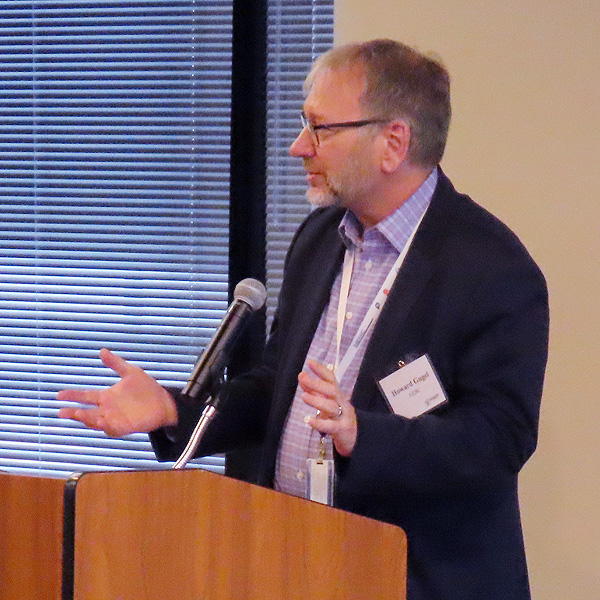 Howard Gugel, NERC | © RTO Insider LLC
Howard Gugel, NERC | © RTO Insider LLC
